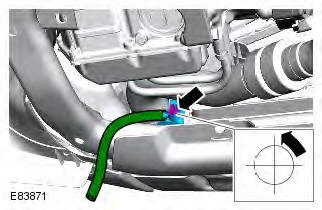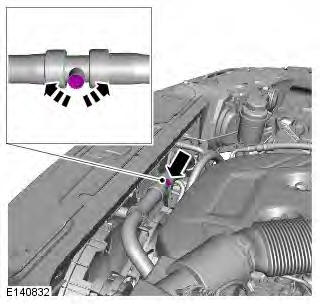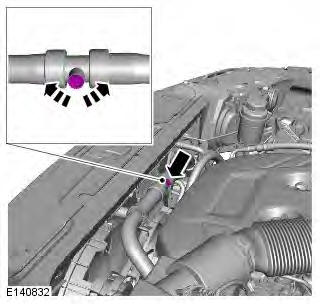Range Rover Evoque: Cooling System Partial Draining, Filling and Bleeding
Draining
CAUTIONS:
The engine cooling system must be maintained with the correct concentration and type of anti-freeze solution to prevent corrosion and frost damage. Failure to follow this instruction may result in damage to the engine.
Engine coolant will damage the paint finished surfaces. If spilt, immediately remove the coolant and clean the area with water.
The engine cooling system must be maintained with the correct concentration and type of anti-freeze solution to prevent corrosion and frost damage. Failure to follow this instruction may result in damage to the engine.
1. WARNING: Make sure to support the vehicle with axle stands. Raise and support the vehicle.
2. Refer to: Engine Undershield (501-02 Front End Body Panels, Removal and Installation).
3. Position a container to collect the fluid.
4.
- Allow the coolant to drain into a suitable container.
- Attach a hose to the radiator drain tap. Open the tap.

5. Tighten the radiator drain tap.
6. Remove the container.
Filling
CAUTIONS:
The engine cooling system must be maintained with the correct concentration and type of anti-freeze solution to prevent corrosion and frost damage. Failure to follow this instruction may result in damage to the engine.
Engine coolant will damage the paint finished surfaces. If spilt, immediately remove the coolant and clean the area with water.
The engine cooling system must be maintained with the correct concentration and type of anti-freeze solution to prevent corrosion and frost damage. Failure to follow this instruction may result in damage to the engine.
1. Lower the vehicle.
2. Open the bleeding port.

3. CAUTION: Anti-freeze concentration must be maintained at 50%.
- Fill the coolant expansion tank until coolant appears through the bleed port.
- Tighten the bleeding port.

4. Fill the cooling system to the upper level mark of the expansion tank.
5. Install the coolant expansion tank cap.
6. Connect exhaust extraction hoses to the tail pipes.
7. Start the engine and allow to idle.
8. Set the heater controls to maximum.
9. CAUTION: Make sure the coolant level remains above the "MIN" level mark. Hold the engine speed at 2000 rpm until warm air is expelled from the heater.
10. Switch the engine off and allow to cool.
11. WARNING: Since injury such as scalding could be caused by escaping steam or coolant, do not remove the filler cap from the coolant expansion tank while the system is hot. Check and top-up the coolant if required.
12. Visually check the engine and cooling system for signs of coolant leakage.
13. Refer to: Engine Undershield (501-02 Front End Body Panels, Removal and Installation).

